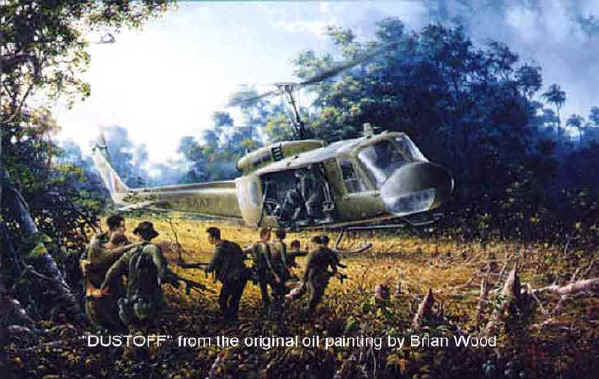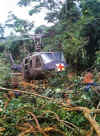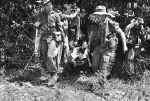 |
|
|||
|
|
||||
|
"No compromise. No rationalisation. No Hesitation. Fly the mission. Now!" |
|
Aero-medical evacuation of the wounded from the battlefield . . . now known as DUSTOFF |
|
|
|
|
|
MedEvac = evacuation for illness or injury |
CasEvac = evacuation of wounded (casualties) |
|
This page is dedicated to John Gillespie RAAMC, an 8th Field Ambulance medical crewman aboard an RAAF helicopter, who was killed carrying out a DUSTOFF mission in the Long Hai Hills on 17th April 1971, after the US Army had withdrawn its DUSTOFF helicopter from Nui Dat, in the run-up to withdrawal of all allied forces from South Vietnam. DUSTOFF is the name given to helicopter ambulances used in wartime casualty evacuation, the name is synonymous with the rapid evacuation of casualties from the battlefield under all battle and adverse weather conditions. The first DUSTOFF unit in Vietnam arrived on 26th April 1962 from Fort Meade, Maryland, USA. This unit, the 57th Medical Detachment (Air Ambulance) with 5 Bell UH-1A "Huey" helicopters, was to service the 8000 United States troops then on the ground in Vietnam. The unit was stationed at Nha Trang close to the US 8th Field Hospital. During November 1962 the 57th's Commanding Officer, Capt John Tamperelli, was ordered to remove and hand over the starter generators from his 5 DUSTOFF helicopters so that they might be used as spare parts in faulty slick ships, despite protests, this left the only air evacuation unit in Vietnam unable to operate from 17th November to 15th December 1962. On 15th December only one generator was returned to the unit and the remaining four of the aircraft remained non-operational. Tamperelli faced many obstacles, General Stilwell attempted to wrest control of the unit from the US Army Medical Corps and allocate it to the US Army Transportation Corps, to remove the Red Cross from the aircraft and reassign them as general utility helicopters. On 16th January 1963, Tamperelli was ordered to move his unit to Ton Son Nuit Air Force Base at Saigon, after a disastrous battle took place in the Mekong Delta. The ARVN 7th Infantry Division, comprising 400 South Vietnamese troops with 50 US advisors had attempted an assault on a Viet Cong stronghold, only to have 4 CH-21 Shawnee helicopters and a new UH-1B helicopter shot down. Three Americans and 65 South Vietnamese were killed. The 57th was too far away at Nha Trang to respond. During February 1963 Tamperelli handed command of the 57th over to Major Lloyd Spencer and, on 11th March 1963, the 57th was re-equipped with 5 new UH-1B's, which were readied for service in a record 12 days after arrival in Vietnam. April saw the assignment of 2 of the 5 helicopters to Pleiku to cover II Corps area. US Marine helicopters covered I Corps with H-34's. The three helicopters left at Ton Son Nuit covered both III and IV Corps area. All Corps areas were now covered by helicopter ambulances. The 57th had no radio call sign of its own and Spencer noticed the vacant call sign DUST OFF in the Signal Operations Instructions. He unofficially assigned the call sign to the unit and sought to make it official. During late 1963 the National Security Agency allocated the name DUST OFF to the 118th Airmobile Company, the 57th fought to retain the name and the 118th refused to use it. It was at this point in history that the call sign DUSTOFF, denoting aero-medical evacuation of the wounded from the battlefield, was set in stone. On 11th January 1964, Major Charles L Kelly took up his post as the third Commanding Officer of the 57th, he was tough, stubborn, willing to take on the top brass and deeply committed to the DUSTOFF concept. One of his first moves was to relocate the two helicopters in Pleiku to Soc Trang, 100 kilometres south west of Saigon, to service the Mekong Delta area. Crews were logging up over 100 hours a month, and logs were being incorrectly compiled, for fear of excess hours groundings by flight surgeons. The unit, again under pressure from General Stilwell to remove the Red Cross and become general utility helicopters, was in for a significant fight. The indefatigable Kelly was not to be beaten, he started flying night evacuation missions and proved that his two aircraft could cover the entire 20,000 square kilometres of the Mekong Delta on a 'milk run'. Each night the aircraft covered 700 kilometres in little over 3 hours. Kelly laid down the rules and adhered to them himself, there could be no refusal to fly a mission, the wounded always came first. On 7th June 1964, Kelly's 57th was paid a farewell visit by Brig Gen Joseph Stilwell, prior to his return to the US. Kelly presented him with a plaque with five red crosses on it and the tail rotor numbers of each of his aircraft. He said to Stilwell, "Here, General, You wanted my goddamned aircraft, take them." 1st July saw Kelly hovering near the ground picking up casualties on a hot LZ, his ship had taken numerous hits and he was repeatedly advised by ground troops to abort the mission, he refused, remarking, "When I have your wounded." Quite suddenly the aircraft pitched up, nosed over to the right, and crashed. Kelly had been shot through the heart with a bullet which came through the open cargo door. He was posthumously awarded the US Distinguished Service Cross, the Vietnamese Military Order of the Medal of Vietnam and the Vietnamese Cross of Gallantry with Palm. He was the 149th American to lose his life in Vietnam and, such was the level of emotion surrounding his death, the name DUSTOFF and the service for which he had given his life became cemented into the history of the war in Vietnam. Never again was DUSTOFF to be under threat of disbandment. DUSTOFF would continue to fly by Kelly's creed: "No compromise. No rationalisation. No Hesitation. Fly the mission. Now!" On 13th September 1967, 45th Medical Company (Air Ambulance) was established at Long Binh. The 45th had the latest UH-1H, fitted with an AVCO L-13 engine giving 27 percent more power than the L-11 of the UH-1D. It was also 9 percent more fuel efficient that the UH-1D giving a greater range. 45th played a vital role in the success of Australian operations in Phuoc Tuy Province, where one ship was permanently stationed at 8th Field Ambulance (Red Earth), Nui Dat. The DUSTOFF ship carried a US crew of three (AC, pilot and crew chief) and 8th Field Ambulance provided the medical crewman. The United States Army DUSTOFF aircraft was withdrawn from permanent service at 8th Field Ambulance, Nui Dat, during November of 1970 and replaced with an armed RAAF slick ship. Several of the medics who had trained and flown with 45th refused to fly with the RAAF whilst the aircraft were fitted with guns, which the RAAF refused to remove; similarly the RAAF refused to apply the traditional Red Cross to the aircraft which was a demand made of it by the medics. There was a period of stalemate, during which RAAF medics were used or aircraft were tasked without medics, until the 'old guard' returned to Australia, and new medics could be trained. The following Royal Australian Army Medical Corps personnel were trained by, and flew with, the United States 45th Medical Company (Air Ambulance) at Long Binh, South Vietnam, during the Vietnam War:
|




